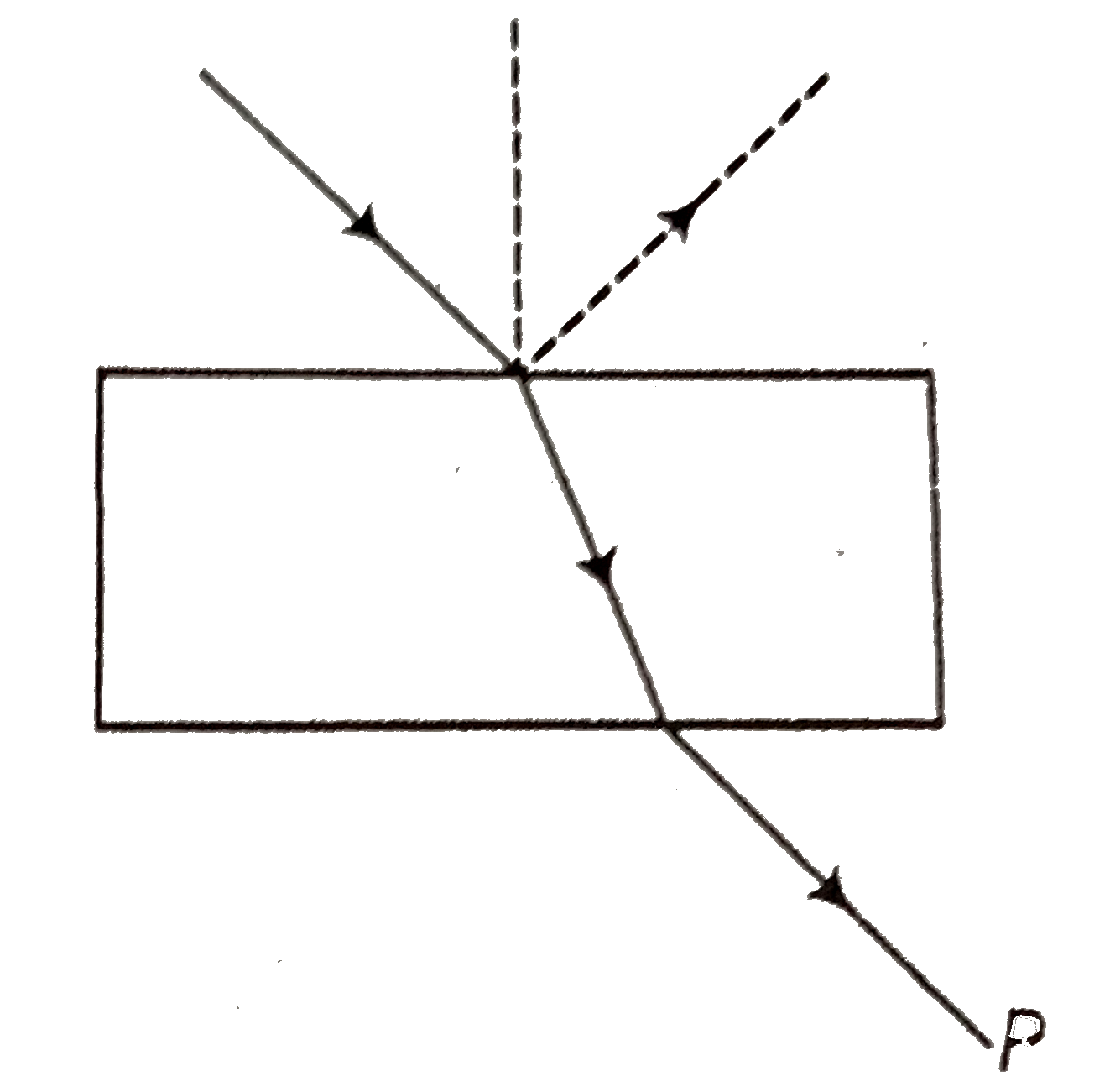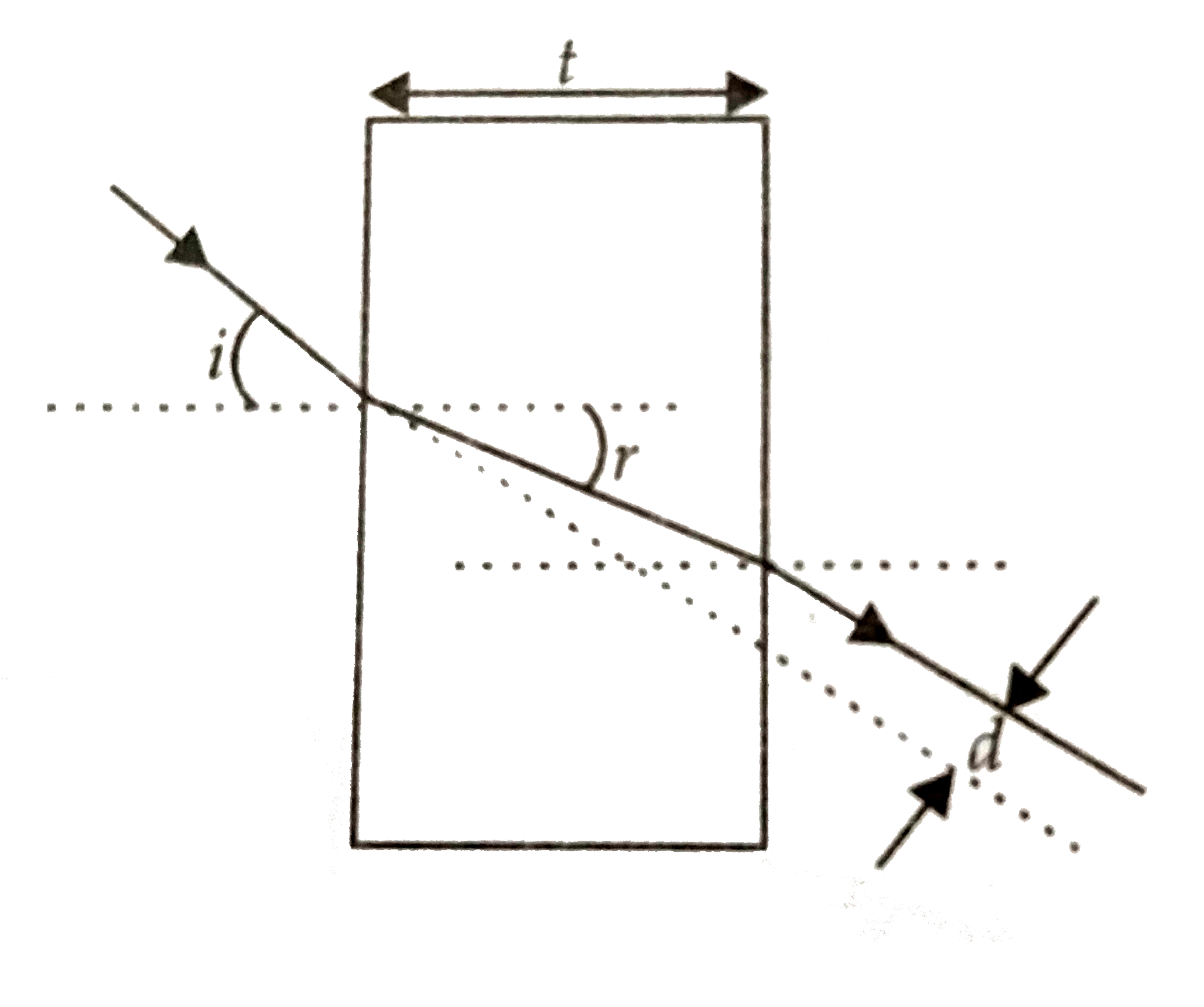Consider a light beam incident from air to a glass slab at Brewster's angle as shown in figure.
A polaroid is placed in the path of the emergent ray at point P and rotated about an axis passing through the centre and pependicular to the plane of the plaroid.

For a particular orientation, there shall be darkness as observed thorugh the polaroid.
The intensity of light as seen thorugh the polaroid shall be independient of the rotation.
The intensity of light as seen through the polaroid shall go through a minimum but not zero for two orientations of the polaroid.
The intensity of light as seen through the polaroid shall go through a minimum for four orientations of the polaroid.
The correct Answer is:C
From Brewster.s law, the light reflected from the top of the glass slab is polarised. The light that is refracted into the glass slab and emerges out of it is only partially polarised. Partially polarised means that other component is not completely absent. Whenever axis of the polaroid gets aligned with this, then intensity will be minimum but not zero. If a polaroid is held in the path of the emergent ray from point P and is rotated about an axis passing through the centre and perpendicular to the plane of the polaroid, the intensity of transmitted light shall go through a minimum but not zero for two orientations of the polaroid. When crystal is rotated, then axis gets aligned twice in one full rotation.
Topper's Solved these Questions
- BOOK - MODERN PUBLICATIONCHAPTER - WAVE OPTICALEXERCISE - NCERT (EXemplar Problems Obejective Questions) (Multiple Choice Questions (Type-II)4videos
WAVE OPTICAL
- BOOK - MODERN PUBLICATIONCHAPTER - WAVE OPTICALEXERCISE - NCERT (Exemplar Problems Subjective Questions) (Very Short Answer Type Questions)6videos
WAVE OPTICAL
- BOOK - MODERN PUBLICATIONCHAPTER - WAVE OPTICALEXERCISE - NCERT FILE SOLVED (Additional Exercises)11videos
WAVE OPTICAL
- BOOK - MODERN PUBLICATIONCHAPTER - SEMICONDUCTOR ELECTRONICS METERIALS DEVICES AND SIMPLE CIRCUITS EXERCISE - CHAPTER PRACTICE TEST FOR BOARD EXAMINATION12videos
SEMICONDUCTOR ELECTRONICS METERIALS DEVICES AND SIMPLE CIRCUITS
Similar Questions
A light ray is incident on a plane glass slab of thickness ‘t’ at an angle of incidence ‘i’ as shown in the figure. If μ is the refractive index of glass. Then find time taken by the light ray to travel through the slab.
View SolutionA ray of light AO in vacuum is incident on a glass slab at angle 60∘and refracted at angle 30∘ along OB as shown in the figure.The optical path length of light ray from A to B is
View Solution
Knowledge Check
- Question 1 - Select One
Consider a light beam incident from air to a glass slab at Brewster's angle as shown in Figure.

A polaroid is placed in the path of the emergent ray at point P and rotated an axis passing through the centre and perpendicular to the plane of the polaroid.AFor a particular orientation there shall be darkness as observed through the polaroid.BThe intensity of light as seen through the polariod shall be independent of the rotation.CThe intensity of light as seen through the Polaroid shall go through a minimum but not zero for two orientations of the polaroid.DThe intensity of light as seen through the polaroid shall go through a minimum for four orientations of the polaroid - Question 2 - Select One
White light is incident on the interface of glass and air as shown in figure. If green ligth is just totally internally reflected then the emerging ray in air contains
 Ayellow, orange, redBviolet, indigo, blueCall coloursDall colours except green
Ayellow, orange, redBviolet, indigo, blueCall coloursDall colours except green - Question 3 - Select One
A short pulse of white light is incident from air to a glass slab at normal incidence. After travelling through the slab, the first colour to emerge is.
AblueBgreenCvioletDred
A plane mirror, reflecting a ray of incident light, is rotated through an angle θ about an axis through the point of incidence in the plane of the mirror perpendicular to the plane of incidence, then
View SolutionA plane mirror, reflecting a ray of incident light, is rotated through an angle θ about an axis through the point of incidence in the plane of the mirror perpendicular to the plane of incidence, then
View SolutionA rays of light is incident on a thick slab of glass of thickness t as shown in figure. The emergent ray is parallel to the incident ray but displaced sideways by a distance d. If the angles are small then d is
 View Solution
View SolutionA plane mirror reflecting a ray of incident light is rotated through an angle of 30∘ about an axis through the point of incidence in the plane of the mirror and perpendicular to the plane of incidence then
View SolutionA ray of light is incident on a parallel-sided glass slab as shown in the figure. The angle of refraction for this ray of light is likely to be :
 View Solution
View Solution

